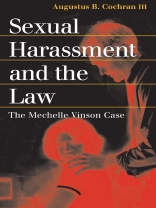Title VII of the 1964 Civil Rights Act may have outlawed sex discrimination, but it did not address the sexual harassment of women in the workplace—behavior that courts did not deem illegal until well into the era of the modern civil rights and women’s movements. Mechelle Vinson’s lawsuit against her employer, Meritor Savings Bank v. Vinson (1986), changed all of that. Adopting the legal theory pioneered by feminist Catharine Mac Kinnon that sexual harassment was indeed discriminatory, the Supreme Court’s opinion, authored by one of the most conservative justices, brought the problem of sexual harassment into the spotlight and placed power relations between men and women at work squarely on the public agenda.
Plaintiff Vinson claimed that she had submitted to the unwanted sexual advances of her supervisor in order to hold onto her job. Although her supervisor denied her charges and the bank he worked for disavowed any knowledge of misbehavior, her suit finally reached the Supreme Court after six years of litigation, where a unanimous Court determined that the creation of a “hostile work environment” through sexual harassment was a form of sex discrimination—and that such harassment could be actionable even without economic injury to the plaintiff.
Augustus Cochran reexamines the origins, contexts, and impact of this landmark decision and introduces readers to the main actors in the drama: bank teller Vinson, her boss and alleged harasser, and a changing cast of jurists. Cochran traces the case from the lower court’s ruling in favor of the bank through the appellate stage overturning that ruling to the Supreme Court’s holding that sexual harassment violates Title VII. He analyzes the decision’s contentious legacy, charting the course of issues raised in the case—hostile environment, unwelcomeness, employer liability—as they have played out in later cases. He also examines new and related legal developments since 1986 and explores the opinions of those who think the laws have gone too far, and of others who think they haven’t gone far enough.
The Supreme Court’s ruling has had far-reaching implications in the workplace and also influenced such high-profile controversies as the Anita Hill-Clarence Thomas hearings, the Tailhook scandal, and the Clinton impeachment. In telling this story, Cochran has written a definitive work on sexual harassment and the law that will fascinate and inform all concerned with equal rights and the empowerment of women.
قائمة المحتويات
Editors’ Preface
Acknowledgments
Introduction: “There Oughta Be a Law”
1. Work, Women, and the Law: Sex Discrimination Becomes Illegal
2. Naming Sexual Harassment: Sexual Harassment Becomes Sex Discrimination
3. Making a Claim: Mechelle Vinson’s Day(s) in Court
4. Deciding the Case: In the Supreme Court of the United States
5. Filling the Gaps: Evolving Issues in the Wake of Vinson
6. Extensions and Retractions: Related Developments since Vinson
7. Judging the Results: The Social Impact of Vinson
Conclusion: Law and Social Change
Chronology
List of Relevant Cases
Bibliographical Essay
Index












